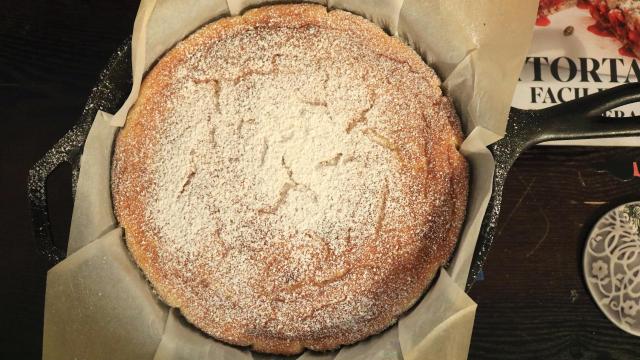Making cheesecake is a pain in the arse, and something I only make for special occasions. Part of the problem is that I go all out. It’s a full production: Crumb crust, full-fat, full-sugar, three inches tall, baked in a water bath until just set, and cooled in the fridge overnight. Since I don’t always want to do all that in order to satisfy my cravings for a luxurious, dense, cheesy dessert, I’ll turn to Migliaccio, and give myself more cheesecake with less hassle by making this Italian semolina cheesecake.
What is Migliaccio?
Comparing migliaccio with an American-style cheesecake is a little unfair. It’s not supposed to be the same texture, and I wouldn’t exactly call it a replacement for the tangy, cream-cheese-centric dessert. Instead of cream cheese, ricotta cheese adds the necessary jiggle and hydration that makes this dessert so dang delicious. As long as you approach this dessert with that in mind, you’ll fall head-over-heels.
In Naples, Italy, migliaccio is a popular dessert to indulge in during Carnevale, a celebration just before the Christian-observed season of Lent. Its flavour profile is mildly sweet and citrusy, owing it all to steeped lemon and orange peels and a small amount of limoncello liqueur. Semolina makes up the bulk of its structure, which means, unlike American cheesecakes, you can eat migliaccio right out of the oven. Not right out — I’m not trying to cause any third degree burns here — but this cake does not rely on cold, set, saturated fats to provide structure and make it sliceable. In fact, warm, aromatic, and custardy is my favourite way to enjoy it. (But if you enjoy cold desserts, this cake firms up to become wonderfully hand-held.)
The biggest selling point for me, is that there is no crust to fuss with and no water bath to endure, cutting the wait time, from baking to eating, down from 10 hours to about an hour and twenty minutes. This means more cheesy cakes for my not-so-special occasions. (Luckily, my life is full of those.)
The batter is also straightforward. I made migliaccio using this recipe from Pina Bresciani, which gives some useful recipe notes at the end, of which, I used two out of the three options. I wanted to have a firmer cake, so I began by draining excess moisture out of my ricotta with some paper towels. If you want things a little softer, the recipe really begins with steeping zest in the milk. The citrus peel and vanilla bean (if using) get removed, and the resulting flavorful liquid is used to make the semolina base. Eggs and sugar are whisked together by hand or in a stand mixer until fluffy. Soon after, ricotta and the cooled semolina base are added to the sugary egg mixture.
How to get it right the first time
There are a few things to note to ensure success. You don’t need to use vanilla bean to season the milk, as the recipe notes mention, but you do need citrus peel. Instead of grating it with a microplane, use a vegetable peeler to get long ribbons of zest. This will make removal easier later.
When you’re ready to add the semolina to the hot milk, use a whisk and pour slowly. If you pour too quickly (or worse, dump it in!), you’ll get lumps. The semolina thickens quickly and, before you know it, the bits you thought you could whisk out will show up in the finished cake.
Once the batter is mixed, you’ll think you’ve made way too much. Yes, it’s quite a bit of batter, but that is common with all cheesecakes. There’s no leavening agent, so you don’t have to plan for much rising. The cake will puff slightly while baking as it releases steam, but settle back down once it cools.
The recipe calls for the use of a springform pan. I don’t have a 9-inch or 10-inch springform, so instead, I lined my cast iron skillet with parchment and baked it in there. It worked perfectly and it had a rustic appeal for serving.
Migliaccio is a great choice if you’re looking for something a little different and low maintenance compared to other cheesecakes. The texture makes it ideal for transporting to a friend’s house or to a picnic, just cool until firm and wrap it up. When you arrive at your destination, you can decide if you’d like to serve it at room temperature or reheat it in the oven on a parchment-lined sheet tray for 10 minutes at 170°C. Its lemony scent will fill the kitchen, its delicate sweetness is a total crowd pleaser, and if you have leftovers, they keep well in the fridge for a few days or in the freezer for up to three months.

Leave a Reply
You must be logged in to post a comment.